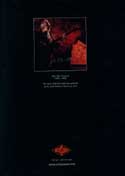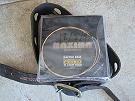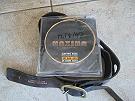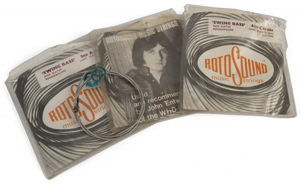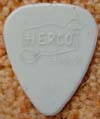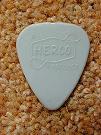John Entwistle’s Gear: Strings, Picks & Action
General equipment notes.
Strings
-
Early ’60s:
Flatwound strings of various manufacturers, including Fender and La Bella.
-
1966–’80s:
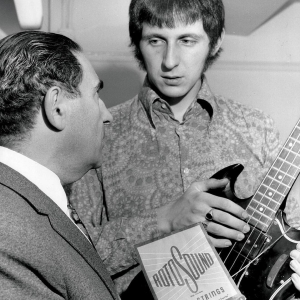
John with sales director Alan Marcuson of Rotosound Strings, and holding a Gibson EB-3 bass.
Rotosound Swing Bass roundwound strings (.045 – .105), developed with John with James How of Rotosound, and changed daily.
From November 1975, Guitar Player interview
- What type of strings do you use?
-
Rotosound. I have to use them — I designed the flaming things! Poor Greg Lake, Chris Squire [laughs]. I was looking for bass strings which vibrated properly, and I couldn’t find a good E and A string on any set at all, except maybe for LaBella — they weren’t too bad. But I wanted a round-wound string. I was approached by Rotosound, and they said they’d make some strings for me, exactly what I wanted. So I went to the factory, and they brought out a set of their round-wound and asked what I thought of them. The E and the A didn’t vibrate properly, and the D and the G weren’t heavy enough. So I sat there all afternoon while they made me strings with different cores, and different gauges, and different types of wire, and finally got through the E, A, D, G, and got a balanced set. And I said, “they’re fine, make me as many sets as you can.” They started making them and said, “look, we’ll put your picture in the string sets, and we’ll put these strings on the market.” So they issued them as “Swing Bass,” and they’ve been out ever since. A lot of people use them and get the same sound as me. I wanted to get a sound like a piano, which is why I wanted round-wound strings; I found that I could play chords and get a lot more sustain out of wire wound, so that’s really why I set out to get the strings done.
From the November 1977 Guitar Player (read an excerpt of the article):
Unlike the vast majority of bassists, John has his strings (Rotosounds) changed before every concert in order to attain maximum crispness. The task is another of Alan Rogan’s responsibilities. Entwistle says, “You don’t get that initial twang if you use the strings again. You can always turn up your treble control to get it like the day before, but then you end up getting a lot of whistle.” Entwistle’s action is probably the lowest of any modern electric bass player. As John laughs, “I like my strings on the *other* side of the frets.”
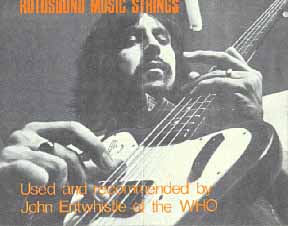
Rotosound ad, courtesy thewho.org.
From April 1995 Bassist interview
- How did the link [with Rotosound] evolve?
-
“It was in 1966 and I was looking for that Danelectro sound again. I tried everybody’s strings but the E and the A’s just didn’t work. It was the same with Rotosound but there was something about them that was almost there but not quite. To solve the problem I got in touch with James Howe[sic] and told him his D and G strings were great but the E and A didn’t vibrate properly. He told me to take my bass along to Rotosound and have some strings made until they got it right. After a couple of hours, we realised that the problem wasn’t in the wire winding, but in the core of the string. You could see that the strings vibrated in a big circle and that was wrong; the core needed to be thicker. We also made the overall gauges a bit heavier and they sent me away with 12 sets to use. A couple of days later they called and asked if I objected to them putting my name to the strings and selling them commercially. I told them I didn’t mind as long as they kept me supplied with free strings! But then we had to do the same with medium and short scale strings because I had loads of different basses by then. Those strings, the RS 66 sets, were the first that vibrated properly other than the Danelectros.”
From August 1989, Guitar Player interview
Another turning point came when I went to Rotosound not long after we recorded “My Generation”. The LaBella strings I’d been using were going dead after each concert, so I visited the Rotosound factory and had them make me sets until they came up with what I was looking for.
-
1989–2001:

Click to view larger version. Maxima Gold strings ad, from International Musician and Recording World magazine, August 1989.
Maxima Gold gold-plated handmade strings, changed daily.
From the August 1989 Guitar Player
The big news is that Rotosounds will not be accompanying the Buzzards on their transcontinental flight. After pioneering the development of roundwound strings with that company in the ’60s and in the process becoming virtually synonymous with the name and the sound, Entwistle has switched to handmade Maxima gold-plated strings. “They sent me a set to try out, and I really liked them. I found that with the proper action on my basses, I could tune the E string as low as an A and still achieve a true tone. I tried to get Rotosound to explore that direction a year ago and they ignored me, and then came out with a set specially gauged by Billy Sheehan that will tune down to a D! So I got fed up. Billy Sheehan and Mark King can sell Rotosounds; I’m very happy with Maximas.”
From April 1995 Bassist interview
“I had been trying to find a decent low B string for the bass and we experimented with Rotosound but didn’t have any luck. A lot of our songs at the time were in C and D, not good keys for bass because you can’t get a good hit of a low C or D, although it isn’t as bad as, say, Eb. I tried de-tuning the Rotosound strings but they lost all their tonal quality. I was then given some gold-plated Maximas to try out about six years ago. While I was putting the first set on and tuning up, I played a low C and it was perfect. It still had the same amount of top end and the tonal quality hadn’t dropped. They had developed a new type of core which was hexagonal or octagonal and you could tune an E string down to a low A and it would still vibrate well. It was those de-tuning possibilities that turned me on to Maxima, plus being gold plated, they looked better with gold hardware and didn’t disappear under the lights on stage.”
-
2001–2002:
Rotosound Swing Bass strings, changed daily.
Auction Profiles
All auction information, including quotes and references are copyright their original owners and are included for reference only. Whotabs makes no claim that these auctions represent authentic Who-used items.
John Entwistle Tour Used Guitar Strings
Julien’s Auctions “Music Icons 2018” on 19 May 2018
A set of four bass strings, three in original Roto Sound packaging, used by John Entwistle while performing with The Who on The Who Tour 1971 in the United Kingdom. Accompanied by a copy of a letter of authenticity from Bill Holdsworth, a roadie on the tour, and a certificate of authenticity from Tracks Ltd.
Packaging, 6 by 5 1/2 inches
Estimate: $800–$1,200
Realised: U.S.$187.50
Picks
-
’60s–’70s:
- Herco
- Manny’s
-
’80s–’90s:
- Herco heavy gauge (.80mm)
- Purple Dunlop 1.14mm Tortex picks.
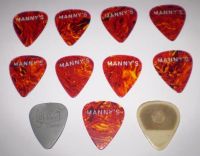
Click to view larger version. John’s Manny’s and Herco picks, courtesy Terry from Who’s Who.
Action
John’s basses were always set up with the lowest possible action.
From the November 1977 Guitar Player (read an excerpt of the article):
“I like my strings on the other side of the frets.”
Resources and Information
Contributors
Thanks to those who have made this page possible:
- Paul Winkler (pw_lists@slinkp.com)
- Brad Rodgers (whocollection.com)
Additional Information:
- Brad Rodgers at whocollection.com.
- Rock Stars Guitars, rockstarsguitars.com.
Manufacturer’s Sites
- Rotosound Strings: rotosound.com
- Maxima: maxima-lines.com/goldb.htm (archived)
- Herco picks (Jim Dunlop)
